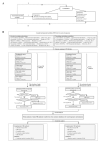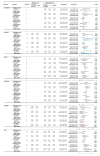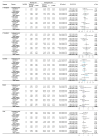Investigating Causal Associations of Diet-Derived Circulating Antioxidants with the Risk of Digestive System Cancers: A Mendelian Randomization Study
- PMID: 35956413
- PMCID: PMC9370260
- DOI: 10.3390/nu14153237
Investigating Causal Associations of Diet-Derived Circulating Antioxidants with the Risk of Digestive System Cancers: A Mendelian Randomization Study
Abstract
Molecular mechanisms and observational studies have found that diet-derived antioxidants are associated with digestive system cancers, whereas there is a lack of causal evidence from randomized clinical trials. In this study, we aimed to assess the causality of these associations through a Mendelian randomization (MR) study. Single nucleotide polymorphisms of diet-derived circulating antioxidants (i.e., α- and γ-tocopherol, ascorbate, retinol, β-carotene, lycopene, and urate), accessed by absolute levels and relative metabolite concentrations, were used as genetic instruments. Summary statistics for digestive system cancers were obtained from the UK Biobank and FinnGen studies. Two-sample MR analyses were performed in each of the two outcome databases, followed by a meta-analysis. The inverse-variance weighted MR was adopted as the primary analysis. Five additional MR methods (likelihood-based MR, MR-Egger, weighted median, penalized weighted median, and MR-PRESSO) and replicate MR analyses for outcomes from different sources were used as sensitivity analyses. Genetically determined antioxidants were not significantly associated with five digestive system cancers, after correcting for multiple tests. However, we found suggestive evidence that absolute ascorbate levels were negatively associated with colon cancer in UK Biobank-the odds ratio (OR) per unit increase in ascorbate was 0.774 (95% confidence interval [CI] 0.608-0.985, p = 0.037), which was consistent with the results in FinnGen, and the combined OR was 0.764 (95% CI 0.623-0.936, p = 0.010). Likewise, higher absolute retinol levels suggestively reduced the pancreatic cancer risk in FinnGen-the OR per 10% unit increase in ln-transformed retinol was 0.705 (95% CI 0.529-0.940, p = 0.017), which was consistent with the results in UK Biobank and the combined OR was 0.747 (95% CI, 0.584-0.955, p = 0.020). Sensitivity analyses verified the above suggestive evidence. Our findings suggest that higher levels of antioxidants are unlikely to be a causal protective factor for most digestive system cancers, except for the suggestive protective effects of ascorbate on colon cancer and of retinol on pancreatic cancer.
Keywords: antioxidant; ascorbate; digestive system cancers; mendelian randomization; retinol.
Conflict of interest statement
The authors declare no conflict of interest.
Figures




Similar articles
-
Diet-Derived Circulating Antioxidants and Risk of Digestive System Tumors: A Mendelian Randomization Study.Nutrients. 2022 Aug 10;14(16):3274. doi: 10.3390/nu14163274. Nutrients. 2022. PMID: 36014780 Free PMC article.
-
Causal association of diet-derived circulating antioxidants with the risk of rheumatoid arthritis: A Mendelian randomization study.Semin Arthritis Rheum. 2022 Oct;56:152079. doi: 10.1016/j.semarthrit.2022.152079. Epub 2022 Jul 28. Semin Arthritis Rheum. 2022. PMID: 35932494
-
Diet-Derived Circulating Antioxidants and Risk of Coronary Heart Disease: A Mendelian Randomization Study.J Am Coll Cardiol. 2021 Jan 5;77(1):45-54. doi: 10.1016/j.jacc.2020.10.048. J Am Coll Cardiol. 2021. PMID: 33413940
-
Mendelian randomization study investigating the relationship between nutrients and polycystic ovary syndrome.Int J Gynaecol Obstet. 2025 Apr;169(1):198-205. doi: 10.1002/ijgo.16029. Epub 2024 Nov 21. Int J Gynaecol Obstet. 2025. PMID: 39569763 Review.
-
Systematic review of Mendelian randomization studies on risk of cancer.BMC Med. 2022 Feb 2;20(1):41. doi: 10.1186/s12916-022-02246-y. BMC Med. 2022. PMID: 35105367 Free PMC article.
Cited by
-
Association between inflammatory bowel disease and pancreatic cancer: results from the two-sample Mendelian randomization study.Front Oncol. 2023 Aug 23;13:1155123. doi: 10.3389/fonc.2023.1155123. eCollection 2023. Front Oncol. 2023. PMID: 37692850 Free PMC article.
-
Potential association of genetically predicted lipid and lipid-modifying drugs with rheumatoid arthritis: A Mendelian randomization study.PLoS One. 2024 Feb 28;19(2):e0298629. doi: 10.1371/journal.pone.0298629. eCollection 2024. PLoS One. 2024. PMID: 38416767 Free PMC article.
-
Causal atlas between inflammatory bowel disease and mental disorders: a bi-directional 2-sample Mendelian randomization study.Front Immunol. 2023 Oct 13;14:1267834. doi: 10.3389/fimmu.2023.1267834. eCollection 2023. Front Immunol. 2023. PMID: 37901213 Free PMC article.
-
Glucosamine supplementation contributes to reducing the risk of type 2 diabetes: Evidence from Mendelian randomization combined with a meta-analysis.J Int Med Res. 2025 Apr;53(4):3000605251334460. doi: 10.1177/03000605251334460. Epub 2025 Apr 29. J Int Med Res. 2025. PMID: 40300556 Free PMC article.
-
Genetically proxied risk and protective factors for pancreatic cancer: a systematic review and meta-analysis of Mendelian randomization studies.J Gastrointest Oncol. 2025 Jun 30;16(3):1233-1247. doi: 10.21037/jgo-2025-305. Epub 2025 Jun 27. J Gastrointest Oncol. 2025. PMID: 40672103 Free PMC article.
References
-
- Edderkaoui M., Hong P., Vaquero E.C., Lee J.K., Fischer L., Friess H., Buchler M.W., Lerch M.M., Pandol S.J., Gukovskaya A.S. Extracellular matrix stimulates reactive oxygen species production and increases pancreatic cancer cell survival through 5-lipoxygenase and NADPH oxidase. Am. J. Physiol. Gastrointest Liver Physiol. 2005;289:G1137–G1147. doi: 10.1152/ajpgi.00197.2005. - DOI - PubMed
MeSH terms
Substances
Grants and funding
LinkOut - more resources
Full Text Sources
Medical

